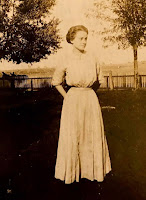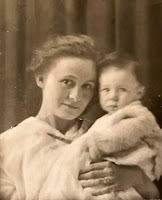The fifth of five girls, the winsome Mary Farris was said to be “spoilt” by her oldest sister, Nora, when I asked Aunt Nora how she remembers my grandmother. This is a word I heard about her before. Spoiled, perhaps, but her daughter Eleanor remembers her as hard-working and a tireless helper to her ailing husband for many years.
Born on a farm in Clifton Hill, Missouri on March 23, 1890 to well-to-do farmer Zachariah Farris, she never got to know her mother, as Nancy (“Nannie Louise”) Farris died a little over a year later. Though not knowing her mother in the flesh, Mary kept her mother sacred by having two photos of her in her album, and by often recounting how her mother died of pneumonia after riding in the rain to fetch material for the five girls’ Easter dresses.
Mary’s middle name was Louis. “Not Louise,” she was known to say. “I was named after my grandfather, Louis.” This grandfather and her grandmother Bunnell became very important in their granddaughter’s life, especially during Mary’s teen years when she lived with them in Salisbury.
Little is known about Mary’s early life other than what can be put together in records. One memory passed down the generations is that there was a time she had to crawl out a window to get onto a horse because the snow was so deep!
Mary was living in Marshall, Missouri in 1908 as an 18-year-old student. Nearly all my life, I had heard she was a college student at Missouri Valley College. However, the college has no record of her. She is instead found at the girls’ school associated with the college. There, she was involved in a number of activities, from reciting prose at a spring program, to basketball,
to being the “prize” in a race in which the college students competed. For some reason, her future husband Tom defaulted the first heat of that race, so Norwood Reed (Reid) won her instead.
Mary kept a few photos of gentlemen from her days in Marshall, but she did not identify them on the photos themselves, nor in her album. However, I have been able to hazard some guesses, and at least one of the gentlemen was quite successful. He became a renowned
Presbyterian minister in Brooklyn. Two others were said to have become very well-to-do.
I understood my grandmother to have many beaux in Marshall, in the Clifton Hill area, and in surrounding towns in Randolph County. There is a photo of her in a carriage with an unidentified
gentleman, and both looked “merry and gay.”
It is not known how or where, exactly, Mary was courted by Tom Warford. Growing up, I understood she met him at college and then married him, as though there were not eight years intervening between the two events. What occurred in those intervening years?
Mary may have gone to Presbyterian Church events or services in Higbee. Perhaps, there was a social event or two. There is a mention in the Moberly paper that Tom attended a “Japanese Lantern” lawn party there; maybe she saw him at similar events.
It is possible Mary did not pay much attention to Tom at first. Looking at the photos of her male friends at Missouri Valley, he is the least dashing of the group, though handsome. But few could beat Tom’s work ethic. And there is something to be said about a coal miner’s son who captures the attention of a town doctor who chose to believe in him. There had to be some burning ambition there, and that fact no doubt had to impress Mary, a hard worker herself even when her sisters thought her over-indulged.
It may have been Tom’s graduation from pharmaceutical school which got Mary to say “yes.” She was on the verge of being an “old maid” by then, and the prospect of few eligible, acceptable men may have been on her mind. Her Grandmother Bunnell was getting “up there” in age at 77 when Mary became Mrs. Warford, and perhaps she did not wish to remain caring for her (Grandma Bunnell lived to age 88).
Moberly newspaper accounts of Mary’s bridal shower show that the majority of ladies present were friends of Tom’s. Mary seems to have had one or two friends from her days in Marshall. But Tom’s adopted sisters made sure Mary was welcomed into their family with open arms.
Photographs of Mary and/or Tom, their children, and their house from their earliest days in Madison, Mo—where Tom established a drug store and soda fountain—show the family as prospering and happy. Mary’s youthful beauty is highlighted as she proudly and lovingly holds her first-born, Hubert Burkhalter Warford.
The Warfords had a neighbor who was a correspondent for Madison news in the Moberly newspaper. Mary’s social comings and goings were duly noted. She attended important church meetings, played bridge, and hosted parties, including a birthday party for daughter Eleanor.
But in 1925, tragedy struck, setting in motion a series of events which changed everyone’s lives forever: Tom Warford was diagnosed and treated for a brain tumor, including pioneering but dangerous surgery at Barnes Hospital in St. Louis. Mom writes, “[H]e was one of three persons having brain surgery, and the only one to survive that kind of surgery. During the surgery a nerve was severed, and he was paralyzed on his left side.”
From Mom’s memoirs, written initially via email or other means to Tom, David, and me and later compiled into a book, “My Life,” we learn much of the flavor of life in the household during the 1920s and 1930s. Though they would seem to some to have had a hard life, it would appear instead they were blessed.
The family managed, Mom says, on $100 per month on an insurance policy. It is possible that insurance sales was one of the many jobs Tom tried out in his youth. He had purchased several policies, most not being any good. Mary Farris Warford was gifted in stretching a dollar. Besides being a talented seamstress—a trait she passed along to her daughter—she, like most others during the Depression knew how to grow and cook their own vegetables and fruit. She wanted also to be a sort of bill collector for her husband who did not have the heart to collect monies owed the pharmacy by people barely getting by.
In some respects, life “went on.” Tom could walk to the main street where he could sit with his friends and talk. He was an avid baseball fan of the St. Louis Cardinals and was able to follow them on the radio after he no longer could attend the games in person. Mary, according to the Higbee News, was socially active, giving parties and attending bridge get-togethers. Mom’s penchant for reading never wavered (nor has it yet, at age 100), Lois was a social butterfly, Hubert built radios and such.
In August 1938, just before Mom’s senior year of high school, faulty wiring in the house’s attic caused a fire. Though the house burned slowly and nearly all the furniture and furnishings were saved, the little town of Madison did not have the equipment and manpower to extinguish it.
The family spent the following year in a rental place. Once again, insurance money came to the rescue, providing for Mary and her family for years, including college tuition for the two daughters. Hubert had been living out of town and later was married before the house fire. Knowing the family had insurance proceeds, and being quite determined, high school valedictorian (of 13 students) Eleanor convinced her parents they should move to Fayette, MO so she could attend college.
The entire family grew up being thrifty and industrious. These were traits that served all well through many hardships. But, as Mom noted in her memoirs, she did not think Mary “was ever truly happy again” after the fire. She was known for her housekeeping, cooking, and sewing and having lived in the Madison house for 22 years, perhaps she felt her identity went up in smoke, too.
In December, 1942, Mom’s sister Lois secretly married her beau just before he left to be a pilot in WWII; in January, 1943 Mom graduated early from college; in April, 1943, Mom and Dad married and left for Alabama; and in the very next month, Tom Warford died at age 54 during his third surgery on his brain.
One can only imagine how Mary Louis Farris Warford felt by that time. She spent 17 years caring for her invalid husband while maintaining a household during the Depression and WWII. All three of her children were married, and she was living in a town where she did not have real roots. But she managed to live on, to age 91.
In the intervening years between 1943 and 1981, Mary moved first to Moberly where she lived several years near her son and his family, and then to Marshall where she was close to her daughter Eleanor and her family. Mom remembers these years as times when, once again, her mother was a hard-working woman making ends meet.
Mary will also be remembered for her sewing and her smiles when talking about her life back in the day. Most of all, she was a strong, loyal, resourceful wife and mother, a model for her children who always adored her.





Comments
Post a Comment